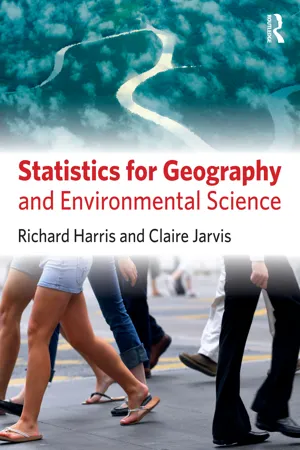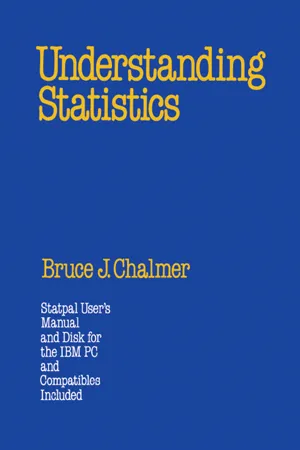Mathematics
Inferences in Statistics
In statistics, inferences refer to the process of drawing conclusions or making predictions about a population based on sample data. This involves using statistical methods to estimate parameters, test hypotheses, and make generalizations. Inferences play a crucial role in understanding and interpreting data, and they help in making informed decisions in various fields such as science, business, and social sciences.
Written by Perlego with AI-assistance
Related key terms
3 Key excerpts on "Inferences in Statistics"
- eBook - ePub
- Giri(Author)
- 2019(Publication Date)
- CRC Press(Publisher)
5 Concepts of Statistics 5.1 INDUCTIVE INFERENCEExperimentation and inference making are the twin essential features of general scientific methodology. A research scientist faced with the problem of studying some characteristics of a natural phenomenon performs an experiment and collects a mass of data relevant to the problem at hand. If the experiment could be repeated indefinitely under similar circumstances, the totality of data so collected would describe the totality of all possible outcomes of repeated occurrences of the phenomenon, and would in this sense yield a physical description of the phenomenon. Calling this totality of data population, and calling the mass of data collected in a single experiment sample, the problem of inference the scientist faces is that of drawing conclusions about the characteristics of the population under study on the basis of the information contained in a sample of observations from a single experiment. An inference of this type is called an inductive inference. Inductive inference thus proceeds from the particular (the sample) to the general (the population).As an example of inductive inference, let us consider a process of manufacturing items that can be classified as defective or nondefective according to some accepted standard. The manufacturer will be happy if this production process does not yield more than 5% defective items. To determine the percentage of defective items, the manufacturer performs the following experiment. He or she draws out, at random, 100 produced items in a row as they come out of the production process and checks each to see whether or not it is defective. The manufacturer must now draw conclusions about the performance of the entire production process on the basis of the number of defective items observed in the sample of 100 items drawn. It is obvious that if an infinite number of such samples of 100 items each could be drawn (in other words, if the experiment could be repeated indefinitely), the totality of these items would demonstrate the relevant characteristic of the production process, namely, the percentage of defective items produced. - Richard Harris, Claire Jarvis(Authors)
- 2014(Publication Date)
- Routledge(Publisher)
5 From description to inferenceChapter overview
We previously have indentified three uses for statistics. These are description, inference and explanation. To this point, the focus has been on description, summarising and showing the centre, spread and shape of a data set. However, Chapter 3 moved towards inference: looking beyond the data in their own right and using them to gather information about the properties of the system, process or structure that has been measured.In this chapter we build on the important distinction between a sample and its population that was introduced in Chapter 4 . Because it is rarely possible to survey a population in its entirety, we aim to have a representative sample of if. However, this creates a problem: if what we learn about a population is based on what we find in the sample, then our information must be sample dependent. Changing the sample would change what we learn about the population.This chapter looks at how we can use the mean and the standard deviation of the sample to estimate the same for the (entire) population. Although we rarely know the true mean of the population, we can calculate the probability that it falls within a specific range of values. We can do this because of the central limit theorem and because of the properties of a normal curve that we reviewed in Chapter 3- eBook - ePub
- Bruce J. Chalmer(Author)
- 2020(Publication Date)
- CRC Press(Publisher)
2Basic Ideas of Statistical Inference
The first task is to make statements about parameters using statistics. The second task is to determine how certain we are that those statements are true. We discuss these tasks in this chapter.2.1 There are two basic tasks of statistical inference.
There are many different types of parameters. We discuss a variety of parameters, together with the corresponding statistics, in later chapters. Each type of parameter describes a particular feature of the population. For example, one parameter often of interest is some sort of average. Or we might want to know the proportions of individuals that fall into various categories on some variable—say, the proportion of light bulbs that bum out within 10 hours, or between 10 and 20 hours, or between 20 and 30 hours, and so on. Other types of parameters involve more than one variable, such as the average loss in fuel economy for each additional kilogram of weight in a car.But whatever parameters are of interest, the basic tasks of statistical inference are the same: to make statements about parameters and to determine how certain we are about those statements. We consider each task in turn.Making statements about parameters using statistics
The first task for which we use statistical inference is to make statements about parameters using statistics. Of course, if we have access to data for the entire population, no inference is needed; we can simply calculate the parameters in which we are interested. But usually, we must use sample statistics to help us make statements about population parameters. These statements can be of several types.Estimation and hypothesis testing
One type of statement about a parameter is simply to estimate its value. An estimate can be a point estimate, meaning a single value, or an interval estimate
Learn about this page
Index pages curate the most relevant extracts from our library of academic textbooks. They’ve been created using an in-house natural language model (NLM), each adding context and meaning to key research topics.


